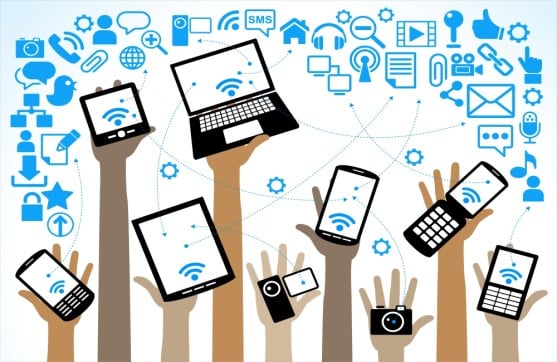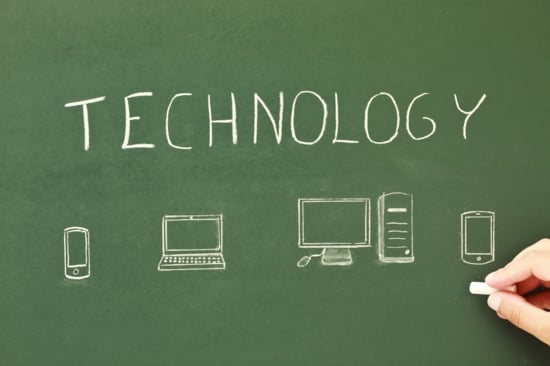In today’s mobile-centric, always connected school environments, keeping up with new technology trends can have a major impact on your continued ability to offer your students the education they want and need.
Schools now recognize the influence wireless and mobile technologies are having on their students as well as how it's shaping new ways of thinking and teaching. More colleges and universities are starting to get on board with utilizing newer learning methods for higher education that are targeted to how students want to learn and what are most effective for them to succeed not only in the classroom but after they graduate.
In order to modernize their campuses for today's digital-native students, many schools are continuing to increase investments in technology related to learning. In fact, funding for educational technology jumped 55% in 2014 and will only increase year-over-year, according to CB Insights.
In addition, Global Industry Analysts (GIA) puts the global e-learning market at $107 billion by the end of 2015, driven by technological advancements and demand for additional skills influenced by wireless and mobile.
But what exactly are the educational technology trends that have been making the biggest waves lately?
To help you continue to offer the latest opportunities to your students here's a list of the top 7 classroom technology trends in the current education environment.
1. Flipped Learning
Flipped Learning is a form of blended learning where students learn their lessons at home by watching video lectures and studying content online, and then doing their homework in class. Basically instead of learning directly from the teacher students learn from each other through a process of small groups using critical problem solving.
By using Wi-Fi enabled classroom technology and various mobile-app solutions you can create the interactive environment that students benefit the most from. The value for educators comes from generating powerful analytics to measure student responses while also having the ability to stay engaged with your students in and out of the classroom.
2. Remote Learning
This model allows students who can't make it to school still attend virtually. They attend class through video and access content online. Other technologies can also be used including video conferencing, class forums, pre-recorded videos, social media, and email.
In the same way you can bring in students remotely, you can also bring in teachers or subject matter experts. This provides a higher quality of learning that would otherwise be unavailable due to distance or time. Education becomes tailored to the needs of the student, making it accessible to everyone. The challenges of time and distance become inconsequential when all you need is a reliable wifi network paired with the right mobile technologies.
3. Gamification
Gamification is the concept of applying game-design thinking to different classroom tasks to make them more fun and engaging. The idea is to use the typical game system of providing challenges, rewarding winners, then providing harder challenges with equally bigger rewards.
When you win at a game, your mind releases dopamine, a chemical in the brain that triggers motivation and pleasure. This makes learning a positive experience, one that you won’t have to force students to enjoy. So the main concept is to challenge the students, let them feel good about overcoming the challenge, then challenge them more.
4. Mind Mapping
Mind maps make learning interactive and multi-dimensional instead of unidirectional and passive. It’s graphic and visual, using circled ideas that are linked together with lines, the same way the human mind works. This makes it easier for students to understand and recall information.
By using software like Mindmeister or Brainstormer, you can engage with your students and allow them to bounce ideas off each other. The maps can also be easily shared just like an email.
5. Digital Textbooks
You might think it would cost more to provide tablets for every student in your school but think of how many textbooks you are saving every year. Textbooks are getting more expensive and they are usually used for seven years before a new edition comes out.
A digital textbook would be more cost efficient and can easily be updated to reflect the most recent information. For the one-time cost of a tablet (or better yet allow BYOD and let students use devices they already own) students are able to access every book they'll need for the year anytime and anywhere.
6. Big Data
Potentially the most important trend on this list, "Big-Data" has the remarkable flexibility and precision to change how we teach and learn.
All of the mobile devices, applications and wireless technologies we use on a day to day basis can now be linked together and harnessed to deliver an almost endless supply of relevant data.
Imagine having the ability to know exactly what works and what doesn't for example:
- Are your students having trouble with how a question is formatted rather than material
- Were your students more successful in the work place after graduation
- Is homework more effective at certain times of night or during certain times of the year
- How many students are understanding the curriculum and how many are falling behind
Big data gives you real-time information that can be applied to your classroom immediately. It also can help your students by allowing you to focus on the areas they actually need help with.
In the connected and mobile age we live in data has become the low-hanging fruit all education leaders should be leveraging to get the most out of new classroom technology.
7. Social Media
Social media is usually considered a huge distraction when it comes to the classroom. From Facebook to YouTube and Twitter many educators are fearful of its use, but this is a short-sided view. With the right strategy in place and the right wireless infrastructure social media can be a very useful and powerful tool for both students and teachers.
There are numerous ways to use social media for learning. An online group can bring students together to work on projects and assignments together and hashtags for Twitter can be used to organize interactive conversations based on a specific subject or problem.
Of course when using social media you have to also teach students how to properly use it, many schools have a digital citizenship code that students must follow that reinforces a positive message around the use of social media in school.
The best thing about social media is that you are using a medium your students understand and enjoy, making it easier for you to initiate tasks and get everyone involved.
It's important to remember while all of these trends sound great they can also cause a lot of frustration without a secure and reliable wireless network and the proper strategy in place.
At SecurEdge we have helped hundreds of schools all over the country successfully bring mobility to their students and staff, if you need help integrating the latest technology into your classrooms or have questions about your current wireless network, just contact us here we'd be happy to help!






